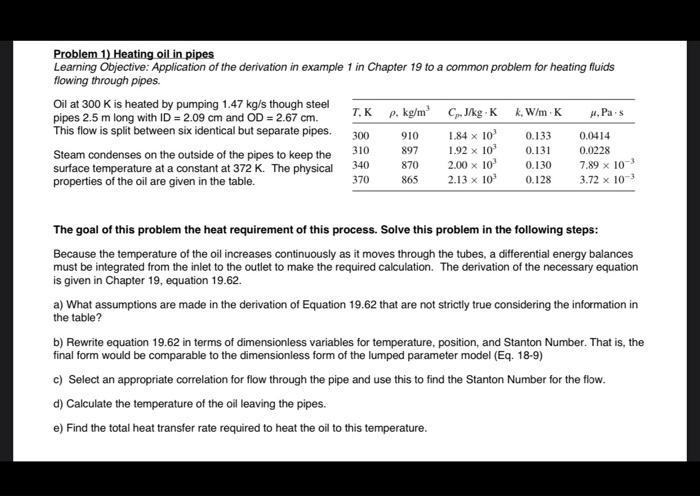Answered step by step
Verified Expert Solution
Question
1 Approved Answer
momentum heat mass and transfer PLEASE DO ALL FOR A LIKE, IF NOT ILL DISLIKE PLEASE BE NEAT ALSO Problem 1) Heating oil in pipes
momentum heat mass and transfer 
Problem 1) Heating oil in pipes Learning Objective: Application of the derivation in example 1 in Chapter 19 to a common problem for heating fluids flowing through pipes. Oil at 300 K is heated by pumping 1.47 kg/s though steel pipes 2.5 m long with ID = 2.09 cm and OD = 2.67 cm. T.K . kg/ml CJ/kg-K kW/ mK M. Pas This flow is split between six identical but separate pipes. 300 1.84 x 10 0.133 0.0414 Steam condenses on the outside of the pipes to keep the 1.92 10 0.131 surface temperature at a constant at 372 K. The physical 340 2.00 x 10 0.130 7.89 x 10- properties of the oil are given in the table. 370 2.13 x 100 0.128 3.72 x 10- 310 910 897 870 0.0228 865 The goal of this problem the heat requirement of this process. Solve this problem in the following steps: Because the temperature of the oil increases continuously as it moves through the tubes, a differential energy balances must be integrated from the inlet to the outlet to make the required calculation. The derivation of the necessary equation is given in Chapter 19, equation 19.62. a) What assumptions are made in the derivation of Equation 19.62 that are not strictly true considering the information in the table? b) Rewrite equation 19.62 in terms of dimensionless variables for temperature, position, and Stanton Number. That is, the final form would be comparable to the dimensionless form of the lumped parameter model (Eq. 18-9) c) Select an appropriate correlation for flow through the pipe and use this to find the Stanton Number for the flow. d) Calculate the temperature of the oil leaving the pipes. e) Find the total heat transfer rate required to heat the oil to this temperature PLEASE DO ALL FOR A LIKE, IF NOT ILL DISLIKE
PLEASE BE NEAT ALSO

Step by Step Solution
There are 3 Steps involved in it
Step: 1

Get Instant Access to Expert-Tailored Solutions
See step-by-step solutions with expert insights and AI powered tools for academic success
Step: 2

Step: 3

Ace Your Homework with AI
Get the answers you need in no time with our AI-driven, step-by-step assistance
Get Started


